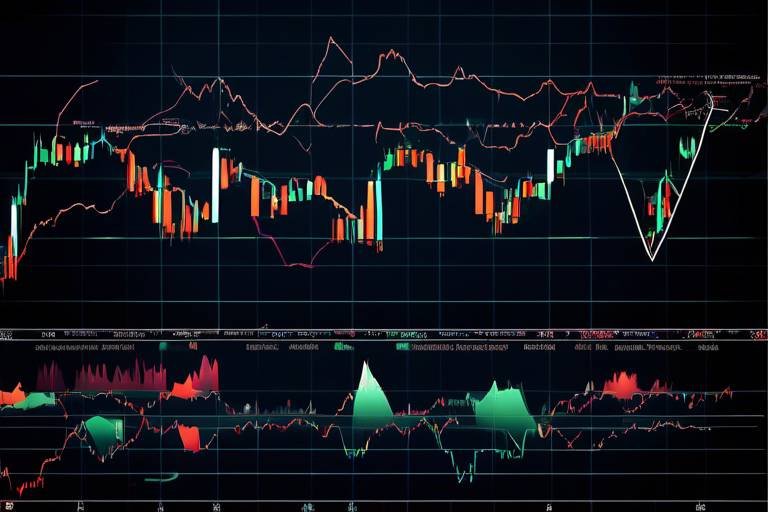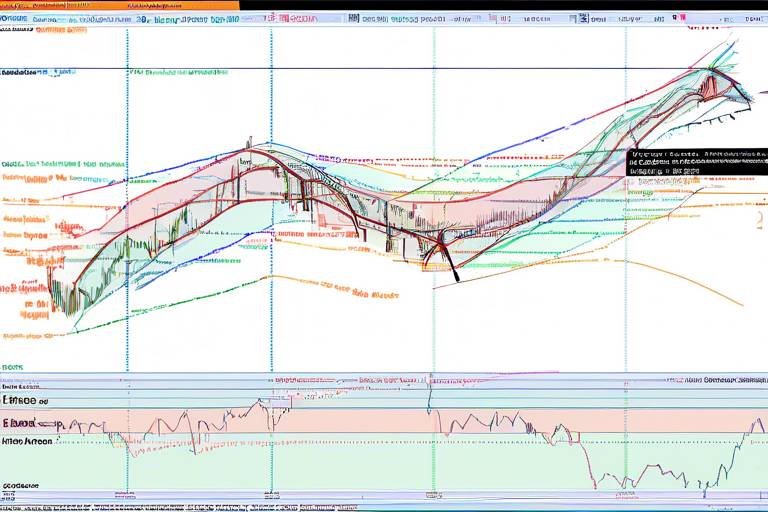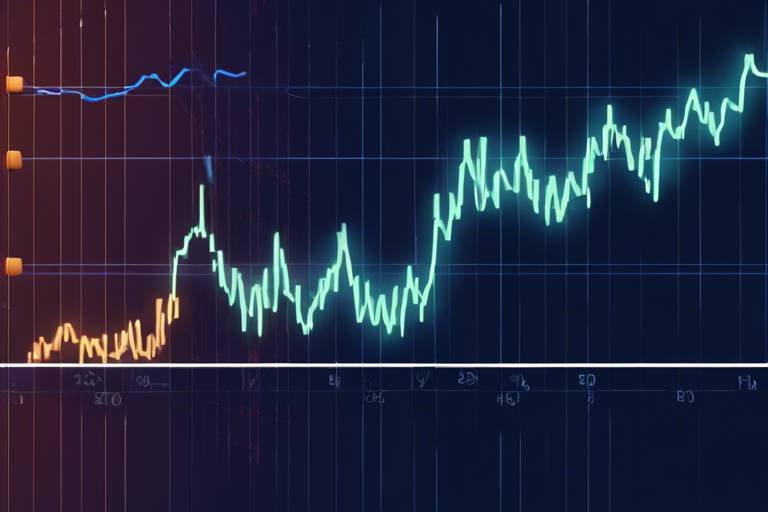How to Optimize Your Technical Analysis Techniques
In the fast-paced world of trading, making informed decisions can feel like navigating through a storm without a compass. However, by honing your technical analysis techniques, you can transform chaos into clarity. This article is your guide to mastering the essential strategies and methods that will elevate your trading game. Whether you're a seasoned trader or just starting out, understanding how to effectively analyze market data can lead to better predictions and more profitable trades.
So, what exactly is technical analysis? At its core, it involves studying historical price movements and trading volumes to forecast future price behavior. Think of it as a detective's toolkit, where each tool—be it chart patterns, indicators, or price action—helps you piece together the bigger picture of market sentiment. By building a solid foundation in these basics, you set yourself up for success in the unpredictable world of trading.
One key element of technical analysis is recognizing that price action is often influenced by human behavior. Just like waves in the ocean, market movements can be erratic, but they often follow recognizable patterns. By learning to read these patterns, you can anticipate potential market shifts and position yourself accordingly. Remember, the goal is not just to react to market changes but to foresee them, giving you a significant edge over less prepared traders.
As we delve deeper into this article, you’ll discover various techniques that can optimize your technical analysis skills. From understanding essential indicators to recognizing chart patterns, each section will equip you with practical knowledge. By the end, you’ll not only be able to analyze data more effectively but also enhance your overall trading strategy, making informed decisions that could lead to greater financial success.
A solid foundation in technical analysis is crucial. This section covers the fundamental concepts, including chart patterns, indicators, and the importance of price action in market analysis.
Identifying and utilizing key indicators can significantly enhance your analysis. This section discusses popular indicators like moving averages, RSI, and MACD, explaining their roles in trading decisions.
Moving averages smooth out price data to identify trends. This subheading delves into different types of moving averages and how they can be applied to optimize trading strategies.
Understanding the difference between simple and exponential moving averages is vital. This section highlights their unique characteristics and when to use each type for better analysis.
This section discusses practical applications of moving averages in trading, including crossover strategies and trend confirmation techniques to improve decision-making.
Momentum indicators help traders assess the strength of price movements. This subheading explores various momentum indicators and how they can enhance your technical analysis.
Chart patterns are essential for predicting future price movements. This section focuses on common chart patterns, their significance, and how to identify them effectively in market trends.
This subheading outlines popular chart patterns such as head and shoulders, double tops, and triangles, explaining their implications for traders and how to spot them.
Integrating chart patterns with technical indicators can provide a comprehensive analysis. This section discusses strategies for combining these tools to enhance trading accuracy.
1. What is technical analysis?
Technical analysis is the study of historical price movements and trading volumes to forecast future price behavior. It involves analyzing charts, patterns, and indicators.
2. How do moving averages help in trading?
Moving averages help traders identify trends by smoothing out price data. They can signal potential buy or sell opportunities when certain conditions are met, such as crossovers.
3. What are momentum indicators?
Momentum indicators measure the strength of price movements, helping traders assess whether a trend is likely to continue or reverse. Popular examples include the Relative Strength Index (RSI) and the Moving Average Convergence Divergence (MACD).
4. How can I combine chart patterns with indicators?
By using chart patterns in conjunction with technical indicators, traders can enhance their analysis. For instance, a breakout from a chart pattern confirmed by a momentum indicator can signal a strong trading opportunity.

Understanding Technical Analysis Basics
When diving into the world of trading, having a solid grasp of technical analysis is like having a treasure map. It guides you through the often turbulent waters of the financial markets, helping you make informed decisions. At its core, technical analysis involves studying past market data, primarily price and volume, to forecast future price movements. This methodology is built on the belief that all necessary information is already reflected in the price, making it crucial for traders to understand various elements such as chart patterns, indicators, and the overall significance of price action.
To fully appreciate the nuances of technical analysis, you need to familiarize yourself with some fundamental concepts. First off, let's talk about chart patterns. These are visual representations of price movements over time, and they can reveal a lot about potential future behavior. By identifying patterns like head and shoulders or double tops, traders can gauge market sentiment and make predictions about price direction.
Next, we have indicators, which are mathematical calculations based on price and volume data. They help traders assess market conditions and make more informed decisions. Some popular indicators include moving averages, Relative Strength Index (RSI), and Moving Average Convergence Divergence (MACD). Each of these indicators serves a unique purpose and can be used in various scenarios to enhance your trading strategy.
Another critical aspect of technical analysis is price action. This refers to the movement of a security's price over time. Understanding price action is essential because it provides insights into market dynamics and trader psychology. For instance, if a stock consistently hits a resistance level and fails to break through, it indicates a strong selling pressure, which can inform your trading strategy.
In summary, the basics of technical analysis encompass a range of tools and techniques that can significantly improve your trading skills. By mastering chart patterns, indicators, and price action, you can develop a more comprehensive understanding of market movements and make informed decisions. Remember, the key to successful trading lies not just in knowing these concepts but in applying them effectively in your trading strategy.

Key Indicators for Effective Analysis
When it comes to technical analysis, understanding and utilizing key indicators can make a world of difference in your trading journey. These indicators act like the compass guiding you through the often tumultuous seas of the financial markets. By leveraging these tools effectively, you can enhance your analysis and make more informed trading decisions. So, what exactly are these indicators, and how can they help you? Let's dive in!
One of the most popular indicators among traders is the Moving Average. This indicator smooths out price data to help identify trends over a specific period. Imagine trying to navigate through a foggy landscape; moving averages clear the air, allowing you to see the direction in which the market is heading. There are various types of moving averages, each serving its unique purpose. For instance, the Simple Moving Average (SMA) calculates the average of a set of prices over a defined period, while the Exponential Moving Average (EMA) gives more weight to recent prices, making it more responsive to new information. Understanding when to use each type can be the difference between a profitable trade and a missed opportunity.
Another crucial indicator is the Relative Strength Index (RSI). This momentum oscillator measures the speed and change of price movements, providing insights into overbought or oversold conditions. Think of the RSI as your market pulse; it tells you when the market is too hot or too cold. A reading above 70 typically indicates that an asset is overbought, while a reading below 30 suggests it is oversold. By keeping an eye on the RSI, you can make more strategic decisions about when to enter or exit trades.
Next up is the Moving Average Convergence Divergence (MACD), another powerful momentum indicator. The MACD consists of two moving averages and a histogram, providing insights into potential buy and sell signals. It’s like having a personal assistant that alerts you when the market is ripe for action. When the MACD line crosses above the signal line, it’s often interpreted as a buy signal, while a cross below can indicate a sell signal. Understanding how to read and interpret the MACD can significantly enhance your trading strategy.
To further illustrate these indicators, let’s take a look at the following table that summarizes their key features and uses:
| Indicator | Type | Key Function |
|---|---|---|
| Moving Average (SMA/EMA) | Trend Indicator | Smooths price data to identify trends |
| Relative Strength Index (RSI) | Momentum Indicator | Identifies overbought or oversold conditions |
| Moving Average Convergence Divergence (MACD) | Momentum Indicator | Signals potential buy/sell opportunities |
In summary, understanding and utilizing these key indicators—moving averages, RSI, and MACD—can significantly enhance your technical analysis. They provide you with crucial insights that can help you navigate the complexities of trading, making your decisions more informed and strategic. So, the next time you analyze a chart, remember to keep these indicators in your toolkit; they could be your secret weapon in the trading arena!
Q: What is the best indicator for beginners?
A: For beginners, the Moving Average is often recommended due to its simplicity and effectiveness in identifying trends.
Q: How do I know which indicator to use?
A: The choice of indicator depends on your trading strategy. It's often beneficial to combine several indicators to get a comprehensive view of the market.
Q: Can I rely solely on indicators for trading decisions?
A: While indicators are valuable tools, it's essential to consider other factors such as market news and economic data for a well-rounded analysis.

Moving Averages Explained
Moving averages are one of the most widely used tools in technical analysis, acting like a compass that helps traders navigate the often turbulent waters of the financial markets. By smoothing out price fluctuations over a specific period, moving averages allow traders to identify trends more clearly. Imagine trying to read a map while driving through a fog; moving averages help clear that fog, presenting a clearer path forward. There are two primary types of moving averages: Simple Moving Averages (SMA) and Exponential Moving Averages (EMA), each with its unique characteristics and applications.
The Simple Moving Average is calculated by taking the arithmetic mean of a set of prices over a specified number of periods. For instance, if you want to calculate a 10-day SMA, you would add up the closing prices of the last ten days and then divide by ten. This method provides a straightforward view of the price trend but can be slow to react to sudden market changes. Think of it as a large ship; it takes time to change direction.
On the other hand, the Exponential Moving Average gives more weight to the most recent prices, making it more responsive to new information. This feature allows traders to react more quickly to price movements, much like a speedboat that can change direction in an instant. The EMA is particularly useful in volatile markets where rapid changes can occur, allowing traders to seize opportunities as they arise.
When deciding which moving average to use, it’s essential to consider your trading style and the market conditions. Here’s a quick comparison of both moving averages:
| Feature | Simple Moving Average (SMA) | Exponential Moving Average (EMA) |
|---|---|---|
| Calculation Method | Average of prices over a set period | Weighted average, prioritizing recent prices |
| Responsiveness | Slower to react | Quicker to respond |
| Best Use Case | Long-term trends | Short-term trading |
Understanding how to use moving averages in your trading strategy can significantly improve your decision-making process. Traders often employ moving average crossover strategies, where they look for points where a short-term moving average crosses above or below a long-term moving average. This crossover can signal potential buy or sell opportunities. For instance, if the 50-day EMA crosses above the 200-day EMA, it might indicate a bullish trend, prompting traders to consider entering a long position.
Moreover, moving averages can also serve as dynamic support and resistance levels. When the price approaches a moving average, it may bounce off it, providing traders with potential entry or exit points. This aspect makes moving averages not just a trend-following tool but also a valuable component in a trader's toolkit for identifying price levels where the market may react.
In conclusion, mastering moving averages is crucial for any trader looking to enhance their technical analysis skills. By understanding the differences between SMA and EMA, and knowing how to apply them effectively, you can navigate the market with greater confidence and precision. As you delve deeper into the world of technical analysis, remember that these averages are just one piece of the puzzle, but they can provide significant insights when used correctly.

Simple vs. Exponential Moving Averages
When it comes to navigating the choppy waters of trading, understanding the difference between Simple Moving Averages (SMA) and Exponential Moving Averages (EMA) can be your lifebuoy. Both of these moving averages are used to smooth out price data, but they do so in distinct ways that can significantly impact your trading decisions. Let’s break it down!
The Simple Moving Average is calculated by taking the average of a set of prices over a specified number of periods. For example, if you’re looking at a 10-day SMA, you would add up the closing prices of the last 10 days and divide that by 10. This method is straightforward and provides a clear view of the overall trend, but it has its drawbacks. The SMA gives equal weight to all prices in the period, which means it can be slow to react to sudden price changes. Imagine trying to catch a bus that just left; it’s hard to catch up if you’re not quick on your feet!
On the other hand, the Exponential Moving Average places greater weight on more recent prices. This means that the EMA reacts more quickly to price changes, which can be advantageous in fast-moving markets. For traders who thrive on speed and want to seize opportunities as they arise, the EMA can be a game-changer. It’s like having a sports car instead of a bus; you can accelerate quickly and maneuver through the traffic of market fluctuations.
To illustrate the differences more clearly, let’s take a look at a comparative table:
| Feature | Simple Moving Average (SMA) | Exponential Moving Average (EMA) |
|---|---|---|
| Calculation Method | Averages all prices equally | Gives more weight to recent prices |
| Speed of Reaction | Slower | Faster |
| Use Cases | Long-term trend analysis | Short-term trading and volatility |
| Sensitivity to Price Changes | Less sensitive | More sensitive |
So, when should you use each type? If you’re focusing on long-term trends, the SMA might be your best bet. It provides a more stable view of the market, helping you avoid the noise of daily fluctuations. However, if you’re a day trader or someone who thrives on quick decisions, the EMA is likely to be more beneficial. It allows you to react quickly to sudden changes, potentially giving you the edge you need to make profitable trades.
In conclusion, understanding the nuances between SMA and EMA can significantly enhance your technical analysis. By knowing when to apply each one, you can make more informed trading decisions that align with your strategy and risk tolerance.

Using Moving Averages in Trading
When it comes to trading, moving averages are like the compass guiding you through the stormy seas of market fluctuations. They help traders navigate by smoothing out price data, allowing for a clearer view of the underlying trend. But how do you actually use these averages in your trading strategy? Well, let’s dive into some practical applications that can elevate your trading game!
One of the most popular methods is the crossover strategy. This approach involves using two moving averages: a shorter-term average and a longer-term average. When the shorter average crosses above the longer one, it generates a buy signal, indicating that it might be a good time to enter a trade. Conversely, when the shorter average crosses below the longer one, it signals a potential sell opportunity. This simple yet effective strategy can help traders capitalize on market momentum.
Additionally, moving averages can be used for trend confirmation. Imagine you’re on a road trip, and the moving average is your GPS. If the price is above the moving average, it suggests that the market is in an uptrend, and it might be wise to look for buying opportunities. On the flip side, if the price is below the moving average, it indicates a downtrend, signaling that you should consider selling. This method is particularly useful for filtering out noise and focusing on the bigger picture.
To illustrate these concepts further, let’s take a look at the following table that summarizes the different moving average strategies:
| Strategy | Description | Signal |
|---|---|---|
| Crossover Strategy | Using a short-term and a long-term moving average to identify buy/sell signals | Buy when short-term crosses above long-term; sell when it crosses below |
| Trend Confirmation | Using moving averages to determine the direction of the trend | Buy when price is above the moving average; sell when below |
| Dynamic Support/Resistance | Using moving averages as dynamic levels of support and resistance | Price bouncing off moving average indicates support; breaking below indicates resistance |
Moreover, moving averages can also serve as dynamic support and resistance levels. Traders often observe how the price interacts with the moving average line. If the price approaches the moving average and bounces back upwards, it can be seen as a sign of support. Conversely, if the price breaks below the moving average, it might act as a resistance level. This dynamic nature provides traders with additional insights into potential price movements.
In conclusion, integrating moving averages into your trading strategy can significantly enhance your decision-making process. By employing crossover strategies, trend confirmations, and recognizing dynamic support and resistance levels, you can make more informed trading choices. Remember, like any tool, moving averages are most effective when used in conjunction with other indicators and analysis techniques. So, keep experimenting and refining your approach!
- What are moving averages? Moving averages are statistical calculations that analyze data points by creating averages over a specific period, helping traders identify trends.
- How do I choose the right moving average for my trading style? The choice of moving average (simple or exponential) often depends on your trading strategy; short-term traders might prefer faster-moving averages, while long-term traders might opt for slower ones.
- Can moving averages predict future price movements? While moving averages can help identify trends and potential reversals, they should not be solely relied upon for predicting future price movements.

Momentum Indicators and Their Importance
When it comes to trading, understanding the strength and direction of price movements is crucial. This is where momentum indicators come into play. These tools help traders gauge the speed at which prices are moving, providing insights into potential reversals or continuations of trends. Imagine trying to catch a wave; if you can sense its strength and direction, you’ll know exactly when to paddle out and ride it. Similarly, momentum indicators can help you identify the right moment to enter or exit a trade.
One of the most popular momentum indicators is the Relative Strength Index (RSI). This tool ranges from 0 to 100 and is typically used to identify overbought or oversold conditions in a market. An RSI above 70 suggests that an asset is overbought, while an RSI below 30 indicates it may be oversold. But don’t just take these numbers at face value; they are best used in conjunction with other indicators to confirm signals, just like a captain wouldn’t rely solely on one navigational tool when sailing.
Another vital momentum indicator is the Moving Average Convergence Divergence (MACD). This indicator not only shows the relationship between two moving averages of a security’s price but also helps traders spot potential buy or sell signals. When the MACD line crosses above the signal line, it can indicate a bullish signal, while a cross below might suggest a bearish trend. Understanding how to interpret these signals is key to making informed trading decisions.
Incorporating momentum indicators into your trading strategy can significantly enhance your ability to make informed decisions. Here’s a quick comparison of some popular momentum indicators:
| Indicator | Purpose | Key Features |
|---|---|---|
| Relative Strength Index (RSI) | Identifies overbought or oversold conditions | Ranges from 0 to 100; typically uses 70/30 thresholds |
| Moving Average Convergence Divergence (MACD) | Shows the relationship between two moving averages | Includes MACD line, signal line, and histogram |
| Stochastic Oscillator | Compares a particular closing price to a range of prices over time | Ranges from 0 to 100; uses %K and %D lines |
While these indicators are powerful, it’s essential to remember that they are not foolproof. They should be used in conjunction with other forms of analysis, such as fundamental analysis and chart patterns. Think of them as pieces of a puzzle; alone, they provide some information, but when combined, they create a clearer picture of the market landscape.
In conclusion, momentum indicators are invaluable tools in a trader's toolkit. They offer insights into market dynamics, helping you make more informed decisions. By mastering these indicators and understanding their implications, you can enhance your technical analysis skills and navigate the trading waters with greater confidence.
- What is a momentum indicator? A momentum indicator is a tool used in technical analysis to measure the speed and strength of price movements, helping traders identify potential trends and reversals.
- How do I use the RSI in trading? The RSI can be used to identify overbought or oversold conditions. Traders typically look for RSI levels above 70 to sell and below 30 to buy, but it’s best to confirm these signals with other indicators.
- What is the best momentum indicator? There isn’t a one-size-fits-all answer; the best momentum indicator depends on your trading style and strategy. Popular choices include RSI, MACD, and Stochastic Oscillator.
- Can momentum indicators be used in all markets? Yes, momentum indicators can be applied across various markets, including stocks, forex, and commodities. However, their effectiveness may vary based on market conditions.

Chart Patterns: Recognizing Opportunities
Chart patterns are like the breadcrumbs left by price movements, leading traders toward potential opportunities in the market. Recognizing these patterns can be a game-changer, as they often signal future price movements. Imagine walking through a forest; if you spot a well-trodden path, you can infer that many have walked that way before, suggesting a good route to follow. Similarly, in trading, identifying chart patterns can help you make informed decisions based on historical price behavior.
One of the most significant advantages of understanding chart patterns is that they provide insights into market psychology. When traders see a particular pattern forming, it often reflects the collective sentiment of the market participants, whether they are feeling bullish or bearish. This emotional aspect can create predictable outcomes, allowing traders to position themselves accordingly. For instance, a pattern like the head and shoulders typically indicates a reversal from a bullish to a bearish trend, while a double bottom suggests a potential upward movement after a downtrend.
To effectively recognize these patterns, traders should familiarize themselves with a few common formations. Here are some key patterns to keep an eye on:
- Head and Shoulders: This pattern indicates a reversal and consists of three peaks, with the middle peak (the head) being the highest.
- Double Tops and Bottoms: These patterns signal reversals; a double top indicates a bearish reversal, while a double bottom suggests a bullish reversal.
- Triangles: These can be ascending, descending, or symmetrical, indicating potential breakout or breakdown points.
Understanding how to spot these patterns is just the beginning. It's crucial to combine your pattern recognition skills with other technical analysis tools, such as indicators and volume analysis, to validate your findings. For example, if you spot a double bottom pattern, checking for increased volume during the breakout can provide additional confirmation of the move's strength. This combination of tools enhances your analysis and increases the likelihood of successful trades.
Moreover, chart patterns are not static; they evolve with market conditions. Therefore, staying updated with market news and trends is essential. Just like a seasoned sailor reads the winds and tides, traders should be aware of external factors that might influence price movements, such as economic indicators, earnings reports, or geopolitical events. This holistic approach to analyzing chart patterns can significantly improve your trading strategy.
In conclusion, recognizing chart patterns is a vital skill for any trader looking to navigate the complexities of the financial markets. By understanding these patterns and integrating them with other analysis techniques, you can uncover opportunities that might otherwise go unnoticed. Remember, the market is a living, breathing entity, and being able to read its signals can set you on the path to success.
Q: How do I start recognizing chart patterns?
A: Begin by studying the most common patterns and practice identifying them on historical charts. Use demo trading accounts to test your skills without risking real money.
Q: Can chart patterns guarantee successful trades?
A: No, while chart patterns can indicate potential movements, they are not foolproof. Always use them in conjunction with other analysis tools and risk management strategies.
Q: How often do chart patterns occur?
A: Chart patterns can occur frequently, but their effectiveness can vary based on market conditions. It's essential to stay adaptable and continuously refine your analysis skills.

Common Chart Patterns
Chart patterns are like the breadcrumbs left behind by market participants, guiding traders through the often chaotic and unpredictable world of trading. Recognizing these patterns is crucial for predicting future price movements and making informed trading decisions. Some of the most common chart patterns include the head and shoulders, double tops, and triangles. Each of these patterns tells a story about market sentiment, and understanding them can give traders a significant edge.
The head and shoulders pattern is one of the most reliable reversal patterns. It consists of three peaks: a higher peak (the head) between two lower peaks (the shoulders). When this pattern forms, it often signals that a bullish trend is about to reverse into a bearish one. Conversely, the inverse head and shoulders pattern indicates a potential bullish reversal, making it a critical pattern to watch for traders looking to capitalize on market shifts.
Next, we have the double tops and double bottoms. The double top is a bearish reversal pattern that occurs after an uptrend, characterized by two peaks at roughly the same price level. This pattern suggests that buyers are losing strength, and a price drop may be imminent. On the flip side, the double bottom pattern signals a bullish reversal, appearing after a downtrend with two troughs at a similar price level. Recognizing these formations can help traders anticipate potential market reversals.
Triangles are another category of chart patterns that traders frequently encounter. They can be classified into three types: ascending triangles, descending triangles, and symmetric triangles. Ascending triangles typically indicate a bullish continuation, while descending triangles suggest a bearish continuation. Symmetric triangles, on the other hand, can break out in either direction, making them a bit more unpredictable but equally important to monitor.
To further illustrate these common chart patterns, here’s a simple table summarizing their characteristics:
| Chart Pattern | Type | Indicates |
|---|---|---|
| Head and Shoulders | Reversal | Bullish to Bearish |
| Double Tops | Reversal | Bullish to Bearish |
| Double Bottoms | Reversal | Bearish to Bullish |
| Ascending Triangle | Continuation | Bullish |
| Descending Triangle | Continuation | Bearish |
| Symmetric Triangle | Continuation | Uncertain |
By familiarizing yourself with these patterns, you can enhance your ability to predict market movements. Remember, though, that while chart patterns are valuable tools, they should not be used in isolation. Combining them with other technical indicators can provide a more comprehensive analysis and increase your chances of making profitable trades.
- What is a chart pattern? A chart pattern is a recognizable formation on a price chart that indicates a potential future price movement.
- Why are chart patterns important? They help traders anticipate market trends and make informed decisions based on historical price movements.
- Can chart patterns guarantee profits? No, while they provide valuable insights, they do not guarantee profits and should be used in conjunction with other analysis methods.

Combining Patterns with Indicators
When it comes to technical analysis, the synergy between chart patterns and technical indicators can be a game-changer for traders. Imagine you’re trying to solve a puzzle; each piece represents a different aspect of market behavior. Alone, each piece can tell a story, but when combined, they create a clearer picture of potential price movements. By integrating chart patterns with indicators, you can enhance your trading strategy and make more informed decisions.
Chart patterns, such as head and shoulders or triangles, provide insights into market psychology and potential reversals or continuations. However, these patterns can sometimes be ambiguous. This is where indicators come into play, acting like a magnifying glass that helps clarify the signals given by the patterns. For instance, if you spot a head and shoulders pattern signaling a potential reversal, confirming this with a momentum indicator like the Relative Strength Index (RSI) can strengthen your conviction. If the RSI is showing overbought conditions at the same time, it adds weight to your analysis.
Consider this scenario: you identify a double top pattern, which typically indicates a bearish reversal. To bolster your analysis, you check the Moving Average Convergence Divergence (MACD). If the MACD line crosses below the signal line during this pattern formation, it can serve as a strong confirmation that the price may indeed be set to decline. This combination of visual patterns and numerical indicators creates a more robust trading signal.
Here’s a quick overview of how to effectively combine patterns with indicators:
- Identify the Pattern: Look for well-defined patterns in the price chart.
- Confirm with Indicators: Use indicators like RSI, MACD, or moving averages to validate your findings.
- Set Entry and Exit Points: Based on the confirmation, decide your entry point and set stop-loss and take-profit levels.
To illustrate this further, let's take a look at a simple table that outlines a few common patterns alongside their ideal confirming indicators:
| Chart Pattern | Confirming Indicator | Signal Type |
|---|---|---|
| Head and Shoulders | RSI | Bearish Reversal |
| Double Bottom | MACD | Bullish Reversal |
| Ascending Triangle | Volume | Continuation |
| Descending Triangle | Moving Averages | Continuation |
In conclusion, the art of combining chart patterns with technical indicators is not just about adding layers to your analysis; it's about creating a more comprehensive strategy. This approach can significantly enhance your ability to predict market movements and make better trading decisions. Remember, the market is a complex ecosystem, and the more tools you have in your arsenal, the more equipped you are to navigate its unpredictable waters.
Q: How do I know which indicators to use with specific patterns?
A: It often depends on your trading style and the market conditions. Experiment with different combinations, and consider backtesting your strategies to see what works best for you.
Q: Can I rely solely on patterns for trading?
A: While patterns can provide valuable insights, they are not foolproof. Always use indicators to confirm your analysis and manage your risk effectively.
Q: How often should I check for patterns and indicators?
A: It depends on your trading strategy. Day traders may check multiple times a day, while swing traders might analyze charts less frequently, focusing on longer-term patterns.
Frequently Asked Questions
- What is technical analysis?
Technical analysis is a method used to evaluate and predict the future price movements of a financial asset by analyzing historical price data and trading volumes. It relies heavily on chart patterns and indicators to inform trading decisions.
- How do I get started with technical analysis?
To get started with technical analysis, familiarize yourself with key concepts such as chart patterns, indicators, and price action. Begin by studying charts and practicing with demo accounts to build your skills without risking real money.
- What are the most important indicators in technical analysis?
Some of the most important indicators include moving averages, Relative Strength Index (RSI), and Moving Average Convergence Divergence (MACD). Each of these indicators serves a unique purpose in assessing market trends and momentum.
- What is the difference between simple and exponential moving averages?
Simple Moving Averages (SMA) calculate the average price over a specific period, while Exponential Moving Averages (EMA) give more weight to recent prices, making them more responsive to price changes. Choosing between them depends on your trading strategy and goals.
- How can I effectively use moving averages in trading?
You can use moving averages to identify trends and generate buy or sell signals through crossover strategies. For instance, when a short-term moving average crosses above a long-term moving average, it may indicate a buying opportunity.
- What are momentum indicators, and why are they important?
Momentum indicators measure the speed of price movements and help traders assess the strength of trends. They are crucial for identifying potential reversals or continuations in market movements, making them an essential part of technical analysis.
- How do I recognize common chart patterns?
To recognize common chart patterns like head and shoulders or double tops, look for specific formations on price charts. Familiarizing yourself with these patterns will help you anticipate potential price movements and make informed trading decisions.
- Can I combine chart patterns with indicators?
Absolutely! Combining chart patterns with technical indicators can provide a more comprehensive analysis. For example, using an RSI along with a head and shoulders pattern can enhance the accuracy of your trading signals.



















